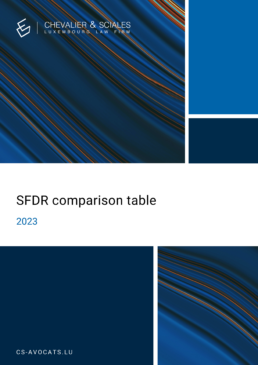SFDR comparison table
Compare two products:
| Dark Green Taxonomy aligned products (art.9 SFDR & art.5 Taxonomy Regulation) | Dark Green non-Taxonomy aligned products (art.9 SFDR) | Light Green Taxonomy aligned products (art. 8 SFDR & art.6 Taxonomy Regulation) | Light Green non-Taxonomy aligned products (art.8 SFDR) | Other products (art.6 SFDR & art.7 Taxonomy Regulation) |
|
|---|---|---|---|---|---|
| Characteristics | • Invest in an economic activity that contributes to environmental objectives as set out under the Taxonomy Regulation and social objectives • Do not significantly harm any of the above objectives • The money is invested in companies which follow good governance practices • Comply with the relevant technical screening criteria set out under Taxonomy Delegated Acts | • Invest in an economic activity that contributes to environmental or social objectives (other than those included in the Taxonomy Regulation) • Do not significantly harm any of those objectives. The money is invested in companies which follow good governance practices | • Promote environmental or social characteristics, or a combination thereof, provided that the companies in which investments are made follow good governance practices • Include some sustainable investments with environmental objectives as set out under the Taxonomy Regulation • Do not significantly harm any of those objectives • Align with the relevant technical screening criteria set out under Taxonomy Delegated Acts | Promote environmental or social characteristics, or a combination thereof, provided that the companies in which investments are made follow good governance practises. They may, further, make some sustainable investments non-Taxonomy aligned | Sustainable investments or promotion of environmental and/or social characteristics is not the objective of the product |
| Scope | All investments of the dark green Taxonomy-aligned product must: • contribute at least to one of the six environmental objectives set out in the Taxonomy Regulation (art. 5 Taxonomy Regulation) • comply with the technical screening criteria set out in the Taxonomy Delegated Acts (art. 3 Taxonomy Regulation) • comply with the principle of ‘Do not significant harm’ (art. 3 Taxonomy Regulation) • be aligned with the OECD Guidelines for Multinational Enterprises and the UN Guiding Principles on Business and Human Rights, the eight fundamental conventions in the Declaration of the International Labour Organisation on Fundamental Principles and Rights at Work and the International Bill of Human Rights (art. 3 Taxonomy Regulation) | All investments of the dark green product must contribute to environmental and/or social objectives other than those set out in the Taxonomy Regulation (art. 9 SFDR) and comply with the principle of ‘Do no significant harm’ (art. 2 SFDR) | Light green Taxonomy- aligned products shall promote environmental or social characteristics, or a combination thereof, provided that the companies in which investments are made follow good governance practises (art. 8 SFDR). In addition, the product may make some Taxonomy-aligned sustainable investments with the following characteristics (art. 6 Taxonomy Regulation): • contribute to one of the six environmental objectives set out in the Taxonomy Regulation (art. 3 Taxonomy Regulation) • comply with the technical screening criteria set out in the Taxonomy Delegated Acts (art. 3 Taxonomy Regulation) • comply with the principle of ‘Do not significant harm’ (art. 3 Taxonomy Regulation) • be aligned with the OECD Guidelines for Multinational Enterprises and the UN Guiding Principles on Business and Human Rights, the eight fundamental conventions in the Declaration of the International Labour Organisation on Fundamental Principles and Rights at Work and the International Bill of Human Rights (art. 3 Taxonomy Regulation) | Light green products shall promote environmental or social characteristics, or a combination thereof, provided that the companies in which investments are made follow good governance practises (art. 8 SFDR). In addition, the product may make some non-Taxonomy aligned sustainable investments contributing to environmental and/or social objectives other than those set out in the Taxonomy Regulation | Other financial products should not make sustainable investments or promote environmental and/or social characteristics (art. 6 SFDR). |
| Disclosures at product level | i. Pre-contractual disclosures on the integration of sustainability risks (art.9 SFDR), positive or negative consideration of principal adverse impacts (art.7 SFDR), sustainable investment objectives (art. 9 SFDR and art. 5 Taxonomy Regulation) ii. Template provided in Annex III of RTS iii. Periodic reports (Annex V of RTS) iv. Website disclosures (art. 10 SFDR) All the above disclosures should be reviewed and adapted regularly. | i. Pre-contractual disclosures on the integration of sustainability risks (art. 9 SFDR), positive or negative consideration of principal adverse impacts (art. 7 SFDR), sustainable investment objectives (art. 9 SFDR) ii. Template provided in Annex III of RTS iii. Periodic reports (Annex V of RTS) iv. Website disclosures (art. 10 SFDR) All the above disclosures should be reviewed and adapted regularly. | i. Pre-contractual disclosures on the integration of sustainability risks (art. 8 SFDR), positive or negative consideration of principal adverse impacts (art. 7 SFDR), promotion of environmental and social characteristics (art. 8 SFDR), sustainable Taxonomy aligned investments (art. 6 Taxonomy Regulation) ii. Template provided in Annex II of RTS iii. Periodic reports (Annex IV of RTS) iv. Website disclosures (art. 10 SFDR) All the above disclosures should be reviewed and adapted regularly. | i. Pre-contractual disclosures on the integration of sustainability risks (art. 8 SFDR), positive or negative consideration of principal adverse impacts (art. 7 SFDR), promotion of environmental and social characteristics (art. 8 SFDR), sustainable non-Taxonomy aligned investments (if any) (art. 8 SFDR) ii. Template provided in Annex II of RTS iii. Periodic reports (Annex IV of RTS) iv. Website disclosures (art. 10 SFDR) All the above disclosures should be reviewed and adapted regularly. | i. Pre-contractual disclosures on integration or not of sustainability risks (art. 6 SFDR), consideration or not of principal adverse impacts (art.7 SFDR) and the statement included in art.7 of Taxonomy Regulation The above disclosures should be adapted in case the product wishes to become a light green product (art. 8 SFDR) or a dark green product (art. 9 SFDR). |
| Disclosures at entity level | Website disclosures: • Sustainability risk policy (art. 3 SFDR) • Positive or negative consideration of principal adverse impacts of investments decisions (art.4 SFDR) • Remuneration policy in relation to the integration of sustainability risks (art.5 SFDR) | Website disclosures: • Sustainability risk policy (art. 3 SFDR) • Positive or negative consideration of principal adverse impacts of investments decisions (art.4 SFDR) • Remuneration policy in relation to the integration of sustainability risks (art.5 SFDR) | Website disclosures: • Sustainability risk policy (art. 3 SFDR) • Positive or negative consideration of principal adverse impacts of investments decisions (art.4 SFDR) • Remuneration policy in relation to the integration of sustainability risks (art.5 SFDR) | Website disclosures: • Sustainability risk policy (art. 3 SFDR) • Positive or negative consideration of principal adverse impacts of investments decisions (art.4 SFDR) • Remuneration policy in relation to the integration of sustainability risks (art.5 SFDR) | Website disclosures: • Sustainability risk policy (if it is considered, otherwise a negative statement and the reasons why sustainability risks are not taken into consideration) (art.3 SFDR) • Positive or negative consideration of principal adverse impacts of investments decisions (art.4 SFDR) • Remuneration policy in relation to the integration of sustainability risks (if they are considered, otherwise a negative statement and the reasons why sustainability risks are not taken into consideration) (art.5 SFDR) |
| Benefits and/or Limitations | Benefits: • Increasing investors’ and market interest • increasing domestic market shares in Luxembourg • Reduced rate of subscription tax depending on the proportion of investments in sustainable economic activities Limitations: • High compliance cost • Possible reclassification of product from art. 9 SFDR to art. 8 SFDR in case investments are not exclusively sustainable | Benefits: • Increasing investors’ and market interest • increasing domestic market shares in Luxembourg Limitations: • High compliance cost • Possible reclassification of product from art. 9 SFDR to art. 8 SFDR in case investments are not exclusively sustainable | Benefits: • Increasing investors’ and market interest • increasing domestic market shares in Luxembourg • More flexible than art.9 SFDR products • Reduced rate of subscription tax depending on the proportion of investments in sustainable economic activities Limitations: • High compliance cost | Benefits: • Increasing investors’ and market interest • increasing domestic market shares in Luxembourg • More flexible than art.9 SFDR products Limitations: • High compliance cost | Benefits: • Lower compliance cost Limitations: • Decreasing investors’ and market interest |
CSSF extends submission deadline for SFDR pre-contractual disclosure data collection
The Commission de Surveillance du Secteur Financier (CSSF) has made significant strides in its efforts to enhance transparency regarding sustainability-related information in the financial sector, guided by the Sustainable Finance Disclosure Regulation (SFDR) and the Taxonomy Regulation (TR). A vital part of this initiative is the data collection exercise relating to pre-contractual product disclosure information. In a recent turn of events, the CSSF announced an extension to the initial submission deadline for this exercise.
In its communiqué issued on 27th July 2022, the CSSF announced its intention to launch a data collection exercise related to SFDR and TR. This move was followed up by a communiqué published on 24th March 2023 detailing the launch of the data collection exercise.
Investment fund managers (IFMs) and institutions for occupational retirement provision (IORPs), qualifying as financial market participants (FMPs), were required to include sustainability-related information in the pre-contractual disclosures of financial products in accordance with SFDR, TR, and the SFDR Regulatory Technical Standards (RTS). The aim of this data collection exercise was to collect, in a digital format, information contained in pre-contractual disclosure documents/templates.
A broad range of FMPs were included in the scope of this data collection exercise, covering UCITS management companies, authorized AIFMs, registered AIFMs in relation to all Luxembourg-domiciled regulated AIFs they manage, and IORPs subject to specific laws.The user guide provided clarifications on the content and the format of the information to be reported.
Following discussions with financial market participants, the CSSF recognized the complexities of SFDR reporting and extended the deadline for the initial report submission on pre-contractual information for all financial products within the scope of the data collection exercise. As per CSSF communiqué dated 4 May 2023, FMPs are now requested to submit their initial report(s) by 15th June 2023 on a best-effort basis, and in any event, by 31st October 2023.
The decision to extend the initial submission deadline for the SFDR data collection exercise on pre-contractual disclosures underscores the CSSF's commitment to engaging with market participants and recognizing the complexities of SFDR requirements. While the extension provides additional flexibility, it is critical for FMPs to stay vigilant and ensure that their disclosures are compliant, accurate, and up-to-date.
If you have any questions regarding the information above, our investment management team is here to help you. Please do not hesitate to contact us for expert guidance.
Latest EU Regulations update: Navigating Sustainability-Related Disclosures and Investments in 2023
In its communication dated 20 April 2023, the CSSF recently drew attention to several publications related to sustainability-related disclosures in the financial services sector. These publications include Regulation (EU) 2019/2088 – SFDR, Commission Delegated Regulation (EU) 2022/1288 (the SFDR RTS), and Regulation (EU) 2020/852 – the EU Taxonomy Regulation.
- The European Commission adopted a third set of Q&As on the interpretation of SFDR, published by the ESAs on 14 April 2023. The first and second sets of Q&As were adopted and published by the ESAs in July 2021 and May 2022, respectively. The third set of Q&As includes amendments to the first and second Q&As.
- The European Commission also published two draft delegated acts relating to the EU Taxonomy Regulation on 5 April 2023. The first draft delegated act provides a new set of technical screening criteria for four environmental objectives, including sustainable use and protection of water and marine resources, the transition to a circular economy, pollution prevention and control, and protection and restoration of biodiversity and ecosystems. It also includes amendments to the Taxonomy Disclosures Delegated Act. The second draft delegated act adds or complements the technical screening criteria for climate change mitigation for certain economic activities in the transport and manufacturing sectors. The draft delegated acts are open for feedback until 3 May 2023.
- Furthermore, the ESAs published a consultation paper on a proposed review of the SFDR RTS regarding PAI and financial product disclosures on 12 April 2023. The consultation period will be open until 4 July 2023.
In light of these recent publications and developments, financial services firms operating within the European Union must ensure that they are compliant with all relevant regulations and delegated acts. Firms should also stay abreast of any updates or changes to these regulations and delegated acts and adapt their compliance programs accordingly.
If you have any questions regarding the information above, our investment management team is here to help. Please don’t hesitate to contact us for expert guidance.
SFDR CSSF FAQ Updates: Fund Names, Sustainable Investments & EPM Techniques
The CSSF (Commission de Surveillance du Secteur Financier) has released on 13 March 2023 an updated FAQ on the Sustainable Finance Disclosure Regulation (SFDR) which offers guidance on adhering to the SFDR requirements. In this article, we will delve into the latest revisions made to questions 7, 8, and 9 in the FAQ.
Q7: Use of ESG and/or Sustainability related terminology in fund names
Question 7 focuses on the use of ESG and sustainability-related terminology in fund names. The CSSF emphasizes that fund names should not be misleading and must align with the fund’s investment objective and policy as well as the applicable guidance on fund names. The CSSF expects Financial Market Participants (FMPs) to utilize terminology like “ESG,” “sustainable,” or “ethical” only when substantiated by evidence of sustainability characteristics that are reflected in the fund’s investment objectives, policies, and strategy as described in the relevant documentation. FMPs must also take note of any updates on this topic at the European level.
Q8: Methodology used to define sustainable investments
Question 8 pertains to the methodology used to define sustainable investments. FMPs must provide investors with the necessary information to make informed judgments about the proposed investment, and they must publish and maintain information on the methodologies used to assess, measure, and monitor the impact of sustainable investments chosen for the financial product. Although further clarification is awaited at the European level, FMPs must provide investors with the methodology used to define sustainable investment and the applied thresholds through mandatory disclosure templates, prospectus, or website disclosures.
Q9: Efficient portfolio management (“EPM”) techniques
Question 9 discusses Efficient Portfolio Management (EPM) techniques. A fund disclosing under Article 9 SFDR may include investments or techniques used for hedging purposes or relating to cash as ancillary liquidity, provided that they align with the sustainable investment objective of the fund. The CSSF expects FMPs to assess the precise purpose of any use of EPM techniques and determine whether they could fall within the “remaining portion” of the investment portfolio when used in the context of funds disclosing under Article 9 SFDR.
In conclusion, the updated FAQ provides more detailed guidance on how FMPs can comply with SFDR requirements, particularly regarding questions 7, 8, and 9. It is critical for FMPs to comply with SFDR requirements and ensure that their fund names are not misleading. Furthermore, FMPs must provide investors with information on the methodology used to define sustainable investments and assess, measure, and monitor their impact.
If you have any questions regarding the information above, our investment management team is here to help. Please don’t hesitate to contact us for expert guidance.
CSSF Notification regarding the amended SFDR RTS
The CSSF would like to bring to the attention of Financial Market Participants (FMPs) that the amended SFDR RTS has entered into force on 20 February 2023. These amendments require precontractual and periodic transparency obligations in relation to Taxonomy-aligned fossil gas and nuclear energy-related activities for financial products disclosing under Articles 8 and 9 of SFDR.
Regarding precontractual documents, FMPs must provide the disclosure information in the format of the templates outlined in the annexes of the amended SFDR RTS for:
- Investment funds launched after the entry into force of the amended SFDR RTS; and
- Existing investment funds that introduce changes in the prospectus/issuing document after the entry into force of the amended SFDR RTS.
With the purpose of simplifying the CSSF review process, in cases where changes to the prospectus/issuing document are limited to the usage of new templates outlined in the appendices of the updated SFDR RTS, FMPs must confirm in the application file submitted to the CSSF that (i) they have utilized the new templates and (ii) no further modifications have been made.
Regarding periodic reports, FMPs must present the periodic disclosure information in the format of the templates set out in the annexes of the amended SFDR RTS for annual reports of investment funds issued after the amended SFDR RTS comes into effect, regardless of the financial year-end of the investment funds.
Please feel free to contact our investment management team should you have any questions concerning the above.
CSSF launches data collection exercise for IFMs on sustainability-related disclosures under SFDR
The CSSF has launched a data collection exercise related to the SFDR. The exercise focuses on the collection of information regarding organisational arrangements of IFMs.
The data collection is necessary for the CSSF to assess the compliance of IFMs with the requirements applicable under SFDR .
The CSSF is requiring Luxembourg-domiciled UCITS management companies, SIAGs, authorised AIFMs, managers of a qualifying venture capital fund registered in accordance with Article 14 of Regulation (EU) No 345/2013 and managers of a qualifying social entrepreneurship fund registered in accordance with Article 15 of Regulation (EU) No 346/2013 to complete a dedicated questionnaire via the launch of a new eDesk module, “SFDR-IFM disclosures” as from 2 February 2023.
The questionnaire must be completed and submitted by an eDesk user linked to the IFM.
The deadline for submission of the questionnaire is 2 March 2023.
IFMs must ensure that the information provided is being kept up-to-date, and can use the “Create update declaration” function under the new eDesk module to allow the amendment of information initially submitted.
The CSSF will communicate further details on timing and practical proceeding of the data collection for the collection of information contained in the PAI statements and in the precontractual and periodic disclosure templates.
The CSSF also reminds industry participants that a Common Supervisory Action exercise (CSA) in relation to sustainability risks and disclosures is currently under discussion at ESMA level, focusing on both SFDR Level 1 and Level 2 provisions as well as the requirements outlined in the ESMA Supervisory Briefing on Sustainability risks and disclosures in the area of investment management.
Taxonomy: EU Commission publishes FAQ to clarify the content of the disclosures delegated regulation under Article 8
The EU Commission published on 6 October 2022 the updated FAQs to clarify the content of the Commission Delegated Regulation (EU) 2021/2178 of 6 July 2021 (the “Disclosures Delegated Regulation”) under Article 8 of Regulation (EU) 2020/852 of 18 June 2020 (the “Taxonomy Regulation”) to assist with its implementation. Article 8 of the Taxonomy Regulation applies to undertakings which are subject to an obligation to publish non-financial information according to Article 19a or Article 29a of Directive 2013/34/EU of the European Parliament and of the Council of 26 June 2013 on the annual financial statements, consolidated financial statements and related reports of certain types of undertakings, as amended (the “Directive 2013/34”). Therefore, large undertakings which are public-interest entities exceeding on their balance sheet dates the criterion of the average number of 500 employees during the financial year should pay attention to the updated FAQs. Idem for the public-interest entities, which are parent undertakings of a large group exceeding on its balance sheet dates, on a consolidated basis, the criterion of the average number of 500 employees during the financial year. The terms large undertakings and public-interest entities are defined in Directive 2013/34.
The prior version of the updated FAQs dated January 2022 contained 22 frequently asked questions on how financial and non-financial undertakings should report taxonomy-eligible economic activities and assets under the Disclosures Delegated Regulation. The Disclosures Delegated Regulation contains disclosure provisions for non-financial undertakings, assets managers, credit institutions, investment firms, insurance and reinsurance undertakings, as well as disclosure rules common to all financial undertakings and disclosure rules common to all financial undertakings and non-financial undertakings concerning the implementation of Article 8 of Taxonomy Regulation.
The 33 frequently asked questions are separated into the following 9 points:
- General FAQs;
- Non-financial undertakings;
- Financial undertakings;
- Asset managers;
- Insurers;
- Credit institutions;
- Debt market;
- Interaction with other regulations;
The EU Commission clarifies the following points in the updated FAQs:
- How is “Taxonomy-eligible economic activity” defined;
- How may asset managers weigh their holdings in a portfolio to report Taxonomy-eligible assets?;
- How to identify Taxonomy-eligible activities of which activity descriptions contain qualifiers, such as ‘low carbon’ and ‘climate-related perils?;
- How should a credit institution with a Markets in Financial Instruments Directive (MiFID) investment firm license report its Taxonomy-eligible economic activities?;
- How to assess and report the Taxonomy-eligibility of a debt asset such as a bond or loan?;
- Can green debt instruments from non-EU entities be reported as Taxonomy-eligible?;
- Can green sovereign debt be reported as Taxonomy-eligible?;
- What activities should an insurer and a reinsurer consider when reporting their underwriting activities in the context of Taxonomy-eligibility reporting?; and
- How does the Disclosures Delegated Regulation interact with the proposed requirements on corporate sustainability reporting (‘the CSRD proposal’)?
The updated FAQ is available here.
Don’t hesitate to contact our banking, finance and capital markets team if you need further information.
CSSF fast-track procedure for visa-stamping regarding SFDR RTS
Introduction
The CSSF issued communications, respectively on 27 July and 6 September 2022, to the investment fund industry relating to (i) the regulatory requirements concerning Regulation (EU) 2019/2088 on sustainability-related disclosures in the financial services sector (the “SFDR”) and the upcoming entry into force of SFDR Level 2 provisions (the “SFDR RTS”), and (ii) the SFDR RTS confirmation letter.
The SFDR RTS requires financial market participants to present by 1 January 2023, for financial products subject to Articles 8 and 9 of SFDR, precontractual and periodic disclosure information in the format of templates set out in the annexes of the SFDR RTS. A fast-track procedure relating to the visa stamp of the issuing documents is now available concerning articles 8 and 9 regulated funds, in other words, UCITS and regulated AIFs (alternative investment funds).
As a reminder, the SFDR RTS also precise mandatory website product disclosure requirements applicable to financial market participants through the need for a separate website section titled, ’Sustainability-related disclosures’. Regulation (EU) 2020/852 of 18 June 2020, on the establishment of a framework to facilitate sustainable investments (the “Taxonomy Regulation”) requires financial market participants, for those financial products subject to Articles 8 and 9 of SFDR, to provide by January 1, 2023, for transparency in pre-contractual documents and periodic reports concerning the environmental objectives referred to in Article 9, points (c) to (f) of the Taxonomy Regulation.
Q.1 What is the fast track process relating to SFDR RTS?
The CSSF expects to receive the updated pre-contractual documents by October 31, 2022, at the latest, for financial market participants who have not yet submitted to the CSSF the required updates to the issuing documents of UCITS and/or regulated AIFs under the SFDR RTS and the Taxonomy Regulation. If submissions following the filing procedure in Q.3 are compliant and received by the CSSF by 31 October 2022, the CSSF will endeavour to release the visa stamp before 31 December 2022.
Q.2 What are the conditions?
The CSSF will give priority for visa stamping to the issuing documents and may release the visa stamp before 31 December 2022, if the following conditions are fulfilled:
– changes made to the pre-contractual documents are limited to the insertion of the templates according to the annexes of SFDR RTS and that for all the sub-funds subject to Article 8 or 9 SFDR;
– the updated filed prospectus is accompanied by the RTS confirmation letter and the related table, duly filled in and signed by authorised persons; and
– any other changes made apart from changes made about the insertion of the standardised annexes pursuant to SFDR RTS must be minor, of editorial nature only and not entail a material change for investors.
Moreover, on an indicative basis, the precontractual and periodic disclosure templates shall not be amended except as foreseen under Article 2 of the SFDR RTS, i.e. the size and font type of characters and the colours. If a financial market participant deems sections of the pre-contractual or periodic template not relevant for a given fund or sub-fund/compartment, those sections shall still be maintained in the precontractual and periodic disclosure template and shown as being not applicable.
Where a notice is foreseen to inform investors of an update of the issuing documents, this notice shall also be uploaded and submitted to the CSSF. Regarding UCITS, the RTS confirmation letter shall be duly filled out and merged with the prospectus in the track change version.
Q.3 What is the procedure?
– Each duly updated UCITS prospectus, including only the sustainability-related disclosure changes, should be filed for visa stamp with an accompanying RTS confirmation letter. A template of the RTS confirmation letter is now available for UCITS from 6 September 2022.
– Each AIF regulated by the CSSF, which, on the basis of Article 6(3) of SFDR, is obliged or intends to publish the pre-contractual disclosure templates in an annexe to its issuing document, shall submit the issuing document to the CSSF within the set deadline. The RTS confirmation letter template for regulated AIFs is now available from 6 September 2022.
The updated pre-contractual documents for visa stamping shall be filed electronically with the CSSF under the provisions set out in Circular CSSF 19/708 relating to the electronic transmission of documents to the CSSF.
Finally, after submission for examination, the CSSF may ask for prompt clarification or confirmation, if needed, with potential reiteration until completion and consent on disclosures to be inserted. Thus, obtaining the visa stamp may also depend on the ability of the applicant to communicate relevant information requested by the CSSF after the first submission of the updated version of the issuing document including the templates, the RTS confirmation letter, and the related table.
Please feel free to contact our investment management team concerning the update of your issuing documents and completion and filing of the RTS confirmation letter and the relevant annexes pursuant to SFDR RTS.
Sustainable Finance - implementation of SFDR level 2 deferred until January 1, 2023
Implementation of the SFDR regulatory technical standards will be deferred by a further six months to January 1, 2023. The European Commission has confirmed this in a letter to the EU Council on November 25, citing the length and technical detail of the legislation. The delay is attributed to the Commission’s desire to ensure the smooth implementation of the rules by fund managers, financial advisers and regulators. The SFDR level 2 provisions were originally due to be implemented at the beginning of 2022, but in July the Commission pushed back the deadline until July 2022 because of hold-ups that delayed agreement on the RTS and the decision to bundle the 13 standards into a single delegated act.
Feel free to get in touch with our investment management team for more information.
Simplication of the submission with the CSSF for new Luxembourg sub-funds
Requests for approval of a new sub-fund within an existing fund structure must be transmitted via a single new questionnaire form, the CSSF has announced, in order to standardise further the information the regulator requires for examination of the application. The CSSF says the new application process will enable the gathering of accurate data, information and documents through one standardised questionnaire, which replaces the following four application questionnaires currently in use. The new questionnaire includes information concerning the Benchmarks Regulation, EMIR and the Sustainable Financial Disclosure Regulation (SFDR). The new questionnaire is valid immediately, but the CSSF will accept the previous ones until March 12.
For any further questions, feel free to contact our investment management team.







